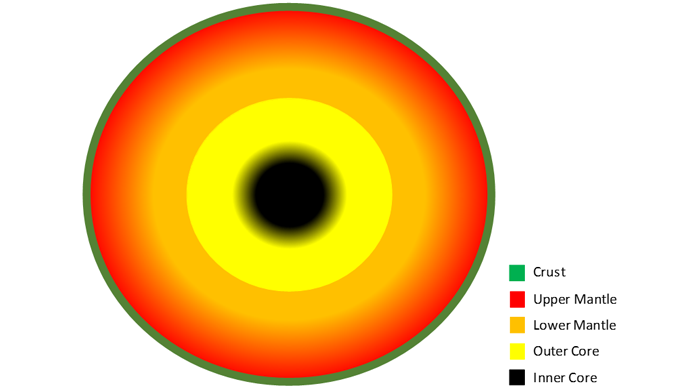Since the occurrence of crude oil and natural gas are intrinsically associated with reservoir rocks, we must start our discussion of the origin and occurrence of natural hydrocarbons with petroleum geology. Geology is the study of all processes that affect the earth. The earth processes studied by geologists occur at many scales from those at the planetary scale (plate tectonics; interactions between the earth’s core, mantle, and crust; etc.) to those at the grain and pore scale (formation of the cementation that binds sand grains, swelling of clays in pores, etc.). Figure 2.01 shows a schematic diagram (not to scale) of the Earth’s Structure.

Through radiometric dating, the earth is believed to be approximately 4.54 billion years old. As shown in Figure 2.01, it is composed of an inner and outer core, the mantle, and the crust. The earth’s crust is the thin, solid, outer shell of the planet that we live on and interact with on a daily basis. The earth’s crust accounts for approximately 1% of the total volume of the planet.
The solid crust is the upper layer of the lithosphere (the lithosphere is composed of rigid crust and upper portions of the semi-elastic mantle). The earth’s crust can be further divided into the oceanic crust and the continental crust. The oceanic crust is between 3 miles (5 km) and 6 miles (10 km) thick and is overlain by approximately 3 miles of seawater; while the continental crust is between 20 miles (30 km) and 30 miles (50 km) thick. Underlying the oceanic crust and the continental crust is a layer of basalt. Because both the oceanic crust and the continental crust are less dense than the mantle, they both “float” on the mantle.
This floating of the crust on the mantle gives rise to the widely accepted theory of Plate Tectonics. Plate Tectonics is the theory that describes the motion of the continents over the geologic time scale. In this theory, the lithosphere is broken into several major tectonic plates and many smaller plates. The major plates are associated with one of the continents. Slow moving convection currents in the upper mantle are the primary driving mechanisms of plate tectonics; while other mechanisms related to gravity are considered to be secondary driving mechanisms. This is illustrated in Figure 2.02.
In this figure, four tectonic plates are shown along with the convection currents that are driving their drift. The direction of the tectonic drift is shown by the arrows. The separation of tectonic plates is referred to as rifting and is caused by the spreading of two or more convection currents. The mid-Atlantic Ridge is an example of rifting zone. Subduction of tectonic plates, where one plate slides below another plate, results when two or more tectonic plates traveling towards each other collide. The resulting zone is called a subduction zone. A third type of plate boundary, where one plate grinds past another plate, is called a transformational boundary. An example of a transformational boundary is the San Andreas Fault where the Pacific Tectonic Plate is moving across the North American Tectonic Plate.
Due to the friction and built-up stresses in subduction zones and transformational boundaries, these plate boundaries are often associated with volcanism and earthquakes. In fact, the “Ring of Fire” which surrounds the Pacific rim and the North American west coast is caused by the movement of tectonic plates interacting with the Pacific Tectonic Plate.
Rift zones and subduction zones are the only locations where mass transfer from the crust to the mantle (and vice versa) can occur. At a rift zone, fresh rock materials are expelled from the mantle; while at a subduction zone, weathered rock material is returned to the mantle. As we will see, this forms an integral part of the Rock Cycle.
